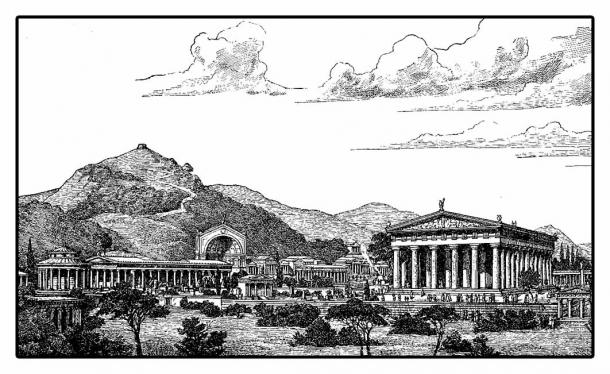
Ancient Olympia: Site Of The Sacred Hieros Gamos
Long before the Greek Olympic Games became the dominion of a male god, ancient symbolism was embedded in the Hieros Gamos (Sacred Marriage ceremony) practiced at Olympia, a sanctuary in a serene valley called Altis, nestled between the Alpheus and Cladeus Rivers in the regional district of ancient Elis, tucked away in the north-west corner of the Peloponnese peninsula of Greece. The Hieros Gamos or Sacred Marriage, embodied the union of the male and female, to celebrate fertility and new life born from the Mother-Goddess. Initially only women participated in rituals and games to honor the goddess, but then invaders usurped the land and annexed the sanctuary and installed their male god, Zeus at Olympia.
The region of Elis was split into three parts; Ceole in the north where the polis of Elis was situated; Pisatis in the middle with the polis of Pisa; and Triphylia, the mountainous area in the south bordering the Alpheus River. The sanctuary of Olympia fell within the administration of Pisa. The name ‘Olympia’ could derive from the word Olympus, an epithet of the goddess Olympia Ge (Mountainous Ge).

19th-century engraving depicting the Sanctuary of Olympia (acrogame/ Adobe Stock)
The ancient Olympia Sanctuary lies at the foot of the Mount Kronos in the Altis valley and priestesses and female athletes ascended this hill to a chasm shaped like vulva in the rocky slope, purported to be the sacred abode of the oracle of the ancient Mother-Goddess, where Chthonia, the First Prophetess, shared her prophesies. Votive offerings were left at an altar for the Mother-Goddess who in her shape as Ge, Gaia, Rhea, Hera, Selene and Demeter, had been worshipped at this sanctuary since prehistoric times, as pottery dating from the Neolithic (4000 – 3000 BC) to the Middle Helladic (1900 – 1600 BC) indicates. Cycladic marble figurines representing the Mother-Goddess were found in the region.
The Tug-Of-War over Olympia
The sanctuary is located just east of the city of Pisa, whose citizens were Achaeans. By the 12th century BC, at the end of the Bronze Age, the region was invaded by the Dorians (Eleans), who settled there and named it Elis. The Achaeans were forced to retreat beyond the Alpheus River to the Triphylia mountains. During the following centuries the Achaeans and the Eleans played tug-of-war over the sanctuary of Olympia with the Achaeans celebrating the Sacred Marriage at the sanctuary, where the Mother-Goddess played the leading role and the Eleans celebrated the games in honor of Zeus, the Father-God.
Like this Preview and want to read on? You can! JOIN US THERE ( with easy, instant access ) and see what you’re missing!! All Premium articles are available in full, with immediate access.
For the price of a cup of coffee, you get this and all the other great benefits at Ancient Origins Premium. And - each time you support AO Premium, you support independent thought and writing.
Dr Micki Pistorius has an Honours Degree in Biblical Archaeology
Top Image: Statue of Hera and Zeus at Panathenaic stadium, Athens. (Sean Wallace-Jones / Adobe Stock)
By: Micki Pistorius















